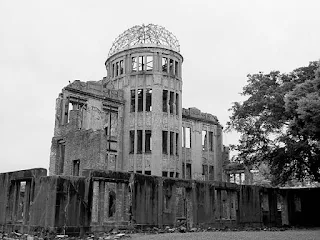On August 6 and 9, 1945, the United States dropped atomic bombs on the Japanese cities of Hiroshima and Nagasaki, respectively.
The Road to the Atomic Bomb
The development of the atomic bomb was a major scientific and technological achievement. It was the culmination of years of research by scientists from many countries, including Germany, Britain, and the United States. In 1942, the United States launched the Manhattan Project, a secret government program to develop an atomic bomb. The project was led by J. Robert Oppenheimer, a brilliant physicist.
The Manhattan Project was a massive undertaking, involving thousands of scientists and engineers. They worked tirelessly to develop the technology needed to create an atomic bomb. In 1945, the project succeeded, and the first two atomic bombs were built.
The Bombings of Hiroshima and Nagasaki
On August 6, 1945, the Enola Gay, a B-29 bomber, dropped the first atomic bomb, code-named "Little Boy," on Hiroshima. The bomb exploded with a force equivalent to 15,000 tons of TNT, destroying much of the city. The immediate death toll was estimated to be between 70,000 and 80,000 people.
Three days later, on August 9, the Bockscar, another B-29 bomber, dropped the second atomic bomb, code-named "Fat Man," on Nagasaki. The bomb exploded with a force equivalent to 21,000 tons of TNT, destroying much of the city. The immediate death toll was estimated to be between 35,000 and 45,000 people.
The bombings of Hiroshima and Nagasaki had a devastating impact on the Japanese people. The cities were completely destroyed, and hundreds of thousands of people were left homeless. The effects of radiation were also terrible. Many people who survived the initial blast died later from radiation sickness.
The Aftermath of the Bombings
The bombings of Hiroshima and Nagasaki had a profound impact on the world. They showed the destructive power of nuclear weapons and led to a global movement to prevent their use. In 1950, the United Nations adopted the Treaty on the Non-Proliferation of Nuclear Weapons (NPT), which prohibits the spread of nuclear weapons.
The bombings also had a lasting impact on the Japanese people. The cities of Hiroshima and Nagasaki have been rebuilt, but the scars of the bombings are still visible. The Hiroshima Peace Memorial Park and the Nagasaki Atomic Bomb Museum are two of the most important memorials to the victims of the bombings.
Facts You May Not Know About the Bombings
- The decision to drop the atomic bombs on Hiroshima and Nagasaki was a controversial one. Some people believe that the bombs were necessary to end the war, while others believe that they were a war crime.
- The United States had considered other targets for the atomic bombs, including Tokyo and Kyoto. However, these cities were spared because they had historical significance.
- The Enola Gay was named after the mother of the pilot, Colonel Paul Tibbets.
- The atomic bombs used in the bombings were the first and only nuclear weapons ever used in warfare.
- The effects of radiation from the bombings are still being felt today. Thousands of people who were exposed to radiation have died from cancer and other diseases.
Conclusion
The bombings of Hiroshima and Nagasaki were a tragedy that had a profound impact on the world. The bombings killed hundreds of thousands of people and caused immense suffering. The effects of radiation continue to be felt today. The bombings also led to a global movement to prevent the use of nuclear weapons.
The bombings of Hiroshima and Nagasaki are a reminder of the terrible consequences of war. They are also a reminder of the need for peace and cooperation among all nations.



